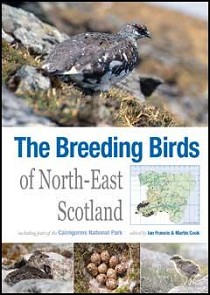The Breeding Birds of North-East Scotland, edited by Ian Francis & Martin Cook

This encyclopaedia details the 189 species that were deemed to have at least possibly bred within Aberdeenshire and Moray over the atlas period of 2002–06. In addition to the obligatory atlas maps, the vast majority of species are also represented by colour photographs, information on breeding biology and habitat preference, current national and regional status and population, as well as trends/changes that have occurred over the past 30 years, thus making it a complete and essential guide to northeast Scotland's birdlife. The detailed inclusion of regional specialities such as Parrot and Scottish Crossbills as well as national scarcities such as Red-backed Shrike helps to render it of interest to birders from all four corners of the British Isles, and not just the treated region.
The word 'complete' is often an unsubstantiated claim in publications. This book goes much further than simply offering detailed species accounts; before this, there are almost forty pages of text, colour images, maps and tables that outline the vast range of habitats that the region possesses, as well as the survey methods employed. Furthermore, chapters 4–6 discuss changes in population and distribution patterns, as well as suitable conservation methods that can be employed to give many of those species at risk a lifeline. Such intricately written and presented extras add strong context to the species accounts, thus entirely justifying the labelling of this book as 'complete'.
Picking faults with the book is nigh on impossible. I did notice one mistake in my search through the species accounts; the photograph used to illustrate Shoveler actually shows a hefty-billed female Mallard with ducklings, rather than the former species. However, given the superhuman quantities of time and effort invested in editing the publication, a minor mishap like this is easily forgiven.
The Breeding Birds of North-East Scotland is a superb reference for local and visiting birders alike; at £25 it is a phenomenal bargain that will undoubtedly provide countless hours of informative reading. The abundance of premium-quality images coupled with a modernistic layout also makes the presentation of the book aesthetically pleasing, which greatly enhances the already fantastic textual content. This publication is the product of an estimated 17,000 hours of observer coverage, with text written by 60 authors and illustrated by images from 62 photographers. The result is, quite simply, superb — a true reflection of the incredible effort put into its creation.
Details of how to purchase a copy of the book can be found online: www.the-soc.org.uk/ne-scotland-atlas.htm



